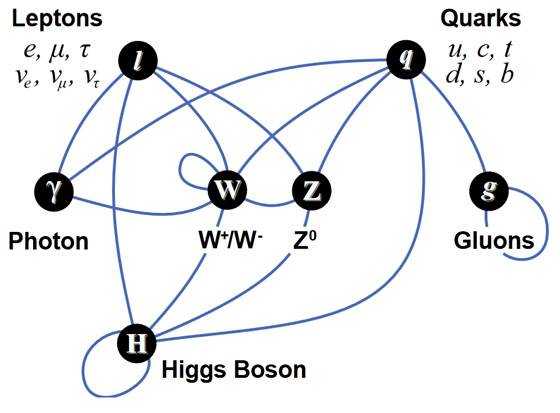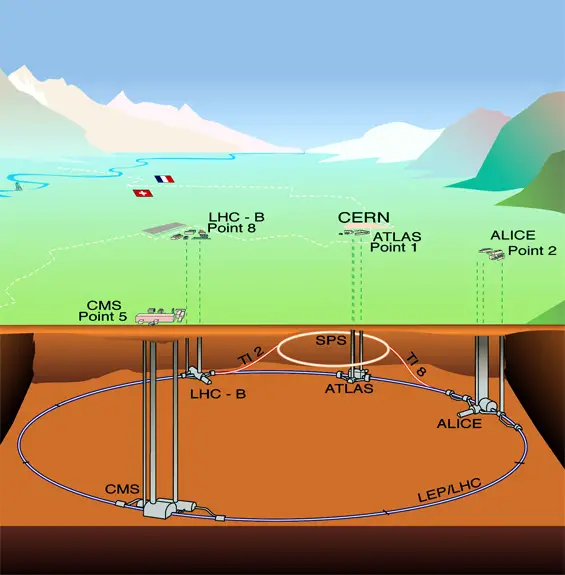
3rd June 2015 The Large Hadron Collider is reactivated The Large Hadron Collider has been reactivated after a two-year pause, during which upgrades and repairs were taking place. The machine is now able to experiment with higher energies, increasing from 8 to 13 trillion electron volts (TeV).
Today, CERN's Large Hadron Collider (LHC) started delivering physics data for the first time in 27 months. After a two year shutdown and several months recommissioning, the LHC is now providing collisions to all of its experiments at the unprecedented energy of 13 TeV (6.5 Tev per beam), a more than 50% increase from the collision energy of its first run. This marks the start of season 2 at the LHC, opening the way to new discoveries. The LHC will now run round the clock for the next three years. "With the LHC back in the collision-production mode, we celebrate the end of two months of beam commissioning," said Frédérick Bordry, CERN Director of Accelerators and Technology. "It is a great accomplishment and a rewarding moment for all of the teams involved in the work performed during the long shutdown of the LHC, in the powering tests and in the beam commissioning process. All these people have dedicated so much of their time to making this happen." Today at 10.40am local time, the LHC operators declared "stable beams", a signal for the LHC experiments that they can start taking data. Beams are made of "trains" of proton bunches, moving at almost the speed of light around the 27 km ring of the LHC. These so-called bunch trains circulate in opposite directions, guided by powerful superconducting magnets. Today the LHC was filled with 6 bunches each containing around 100 billion protons. This rate will be progressively increased as the run goes on to 2,800 bunches per beam, allowing the LHC to produce up to 1 billion collisions per second. During the first run of the LHC, the ATLAS and CMS experiments announced the discovery of the so-called Higgs boson, which was the last piece of the puzzle known as the Standard Model, a theory that describes the fundamental particles from which everything visible in the universe is made, along with interactions at work between them.
"The first 3-year run of the LHC, which culminated with a major discovery in July 2012, was only the start of our journey. It is time for new physics!" said CERN Director General Rolf Heuer. "We have seen the first data beginning to flow. Let's see what they will reveal to us about how our universe works." With run 2 starting today, physicists have the ambition to further explore the Standard Model and even to find evidence of new physics phenomena beyond its boundaries, which could explain remaining mysteries such as dark matter, believed to make up about a quarter of the universe, or nature's apparent preference for matter over antimatter, without which we would not exist. Over the two-year shutdown, the four large experiments – ALICE, ATLAS, CMS and LHCb – also went through an important programme of maintenance and improvements in preparation for the new energy frontier.
"The collisions we are seeing today indicate that the work we have done in the past two years to prepare and improve our detector has been successful and marks the beginning of a new era of exploration of the secrets of nature," said CMS spokesperson Tiziano Camporesi. "We can hardly express our excitement within the collaboration: this is especially true for the youngest colleagues." "The successful restart of physics data-taking, with all systems in great shape to collect, process and analyse the new data quickly, is a testament to the commitment and immense hard work of very many people from across ATLAS during the long shutdown," said Dave Charlton, spokesperson for ATLAS. "We are now starting to delve into the new data to see what nature has in store for us at these new unexplored energies." "All within the collaboration are tremendously excited that the new run has now begun," said LHCb spokesperson Guy Wilkinson. "It will allow us to follow up on puzzles from our run-1 studies, and to probe with higher sensitivity the difference in behaviour between matter and antimatter." "Proton-proton collisions will provide essential reference data for the run with heavy-ion beams foreseen for the end of the year, in which the LHC will provide both higher energy and luminosity as compared to run 1," said ALICE spokesperson Paolo Giubellino. "In addition, we plan to extend the exploration of the intriguing signals that have emerged from Run 1." There are plans for even larger experiments in the decades ahead. China is planning a 52 km (32.5 mi) particle accelerator – twice the circumference of the LHC – with construction beginning in 2019 and the first tests in 2028. Meanwhile, a successor to the LHC known as the Very Large Hadron Collider (VLHC) with 50 TeV per beam is planned for 2035.
Comments »
|









